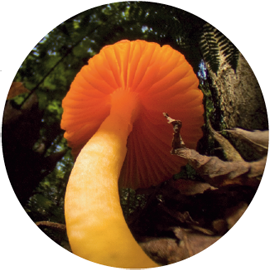For Big Red Mycologists, The (Mushroom) Hunt Is On
FOR BIG RED MYCOLOGISTS, THE (MUSHROOM) HUNT IS ON
what does kathie hodge study? Hint: In her office in plant pathology, there's a box of mushroom-shaped candies, a hat made of "mushroom felt," skeins of tan wool colored with mushroom dye, and a bag of dog biscuits made from . . . you guessed it.

Hodge, PhD '98, adores all things fungi; every Wednesday during the first half of fall semester, she takes her students in Plant Pathology 319 ("Mushrooms of Field and Forest") out to troll for specimens. "Then," she says, "we come back and try to figure out what they are." She also goes mushroom hunting for fun; she tells a cautionary tale about some colleagues who were ticketed by the Department of Environmental Conservation for "illegal clearance of vegetation" while carrying buckets of chanterelles from nearby Connecticut Hill. When she's not in the field, the lab, or the classroom, she tends the Cornell Mushroom Blog, which features sumptuous photographs, plentiful news of the weird (in the world of fungi, you don't have to look far), even a first-person tale of surviving accidental ingestion of the deadly Amanita virosa by Wilson Lab employee Richard Eshelman.
Hodge is also director of Cornell's Plant Pathology Herbarium, a collection of fungi and plant disease specimens documenting the planet's biodiversity. It's either the fourth or fifth largest in North America; it's hard to tell which, because there's no exact count of how many items—somewhere between 300,000 and 400,000—it actually has. They're housed in small boxes or envelopes, each marked with where and when it was collected, in 144 hulking metal storage cases, with some entries dating to the 1880s. Some 2,000 of the specimens came to Cornell via S. C. Teng, MS '26; considered the father of mycology in China, Teng smuggled the specimens out of Nanking by oxcart during the Japanese invasion of 1937. This fall, many of the samples will be halved, with one part kept at Cornell and the other repatriated to China.
The collection used to be located next door to Hodge's office, but seven years ago it was evicted due to space needs, and since then it has been lodged in a former poultry house, a tractor garage in the basement of Riley-Robb, and rented space at the Emerson Power Transmission plant. In October it moved to its new home, a 4,400-square-foot, climate-controlled facility in a former chicken barn off Game Farm Road.
Last year, a fungus hunt in the Cornell Plantations Wild-flower Garden may have yielded a new entry. A visiting mycology professor from China, Bo Huang, did the collecting: a pinch of rotting leaf litter. The sample was put in a Petri dish with a growth medium inside the cover, and a microfungus in the unassuming speck of dirt shot its spores upward. Under the microscope, he and Hodge saw what they believe is an entirely new genus, whose structures she describes as "little plastic tubes" or "little secondary rockets.""It's kind of pretty, actually," says Hodge, noting that although some 250,000 species of fungi have been identified, that's believed to be only 5 percent of what's out there. "It's not that hard to find a new one," she says, "but it's still exciting." Though she hesitates to trumpet the discovery pending peer review, she has tentatively named the find in honor of Ezra Cornell: Drechslerospora cornellii.


